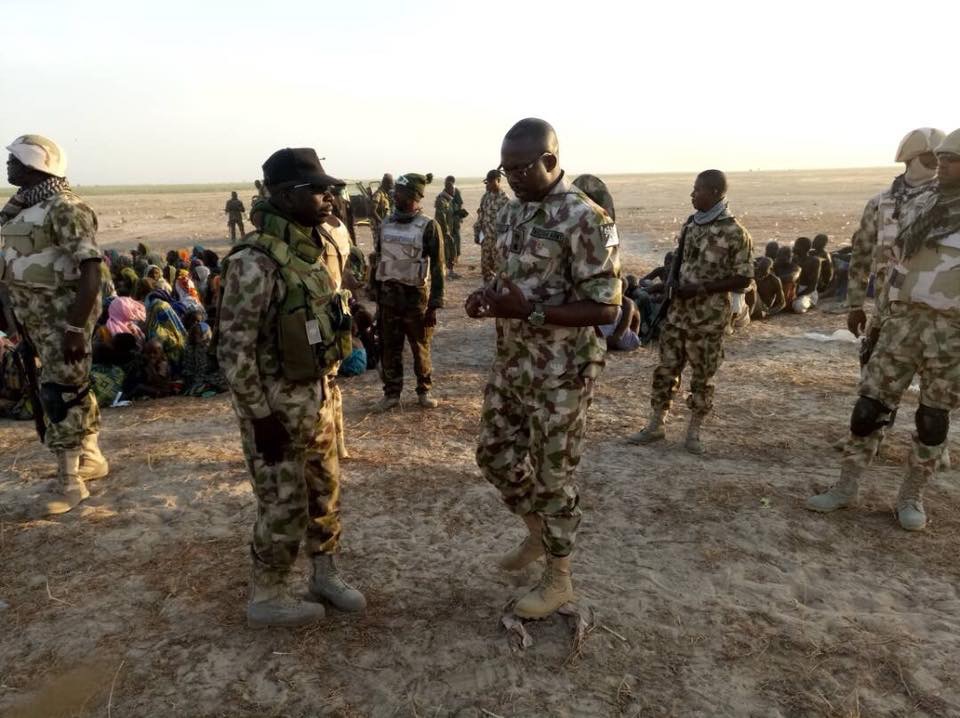OPINION
Now That New York Times Is Back On The Offensive By Richards Murphy

At a time that the media industry, globally, is confronting dwindling revenue for a host of reasons, it appears the New York Times is yet to fully harness the full potentials of revenue models available to it. New York Times only needs apply a little touch to its so called investigative stories to deliver a readymade blockbuster script to Hollywood in the fiction category. A recent piece by the publication, “They Fled Boko Haram, Only to Be Raped by Nigeria’s Security Forces” would break the cinema once appropriately titled “Travesty” or “Multiple Jeopardy”.
The piece tells the story of Falmata, a teenager who was repeatedly raped by Boko Haram abductors only to fall into the hands of military rapists when she escaped from the terrorists. Consistent with Hollywood standards of scripting these kind of flick, there is a near happy ending as “Falmata now lives with her grandmother, but is too ashamed to tell her what happened. Someday, she hopes to continue her education and become a lawyer. She wants to represent the powerless.”
The “travesty” is not that fourteen-year-old Falmata was reportedly abused and exploited by persons who should be protecting her from terrorists; the travesty is that New York Times is again shamelessly peddling its crisis entrepreneur wares to the unwary world. In that single piece the American media organization encapsulated its arrogance, cowboy impunity and disdain for races other than the ones it holds as superior – a justification for its persistent agenda for the destabilization of other countries.
This same New York Times, between September 2002 and June 2003, frantically reported how Saddam Hussein of Iraq possessed a frightening arsenal of “Weapons of Mass Destruction”, which turned out to not only be a lie but such agenda driven journalism laid the foundation for the chaos that today reigns supreme in Iraq. Writing in ‘The Public Editor” section of the paper, Daniel Okrent on May 30, 2004 quoted a Bill Keller as admitting that there was an internal examination of the flawed journalism that contributed to misleading the world about the weapons of mass destruction hoax.
There is no debate as to whether the likes of New York Times were remorseful about the lies and pandering to the agenda of bloodthirsty western politicians in reporting once stable countries into crises. The glee with which New York Times marketed the “Arab Spring” as the next best thing since the discovery of anti-biotics is enough proof that once a group of entitled people become addicted to lying to destroy others there is no turning back.
The Arab Spring, contrary to what New York Times and others in the ‘Fake Mainstream Media’ (credits to President Donald Trump) want us to believe, the countries that were touted as being on the way to becoming democratic free market entities are everything but that. Almost all the nations whose citizens were gullible enough to be misled by the idyllic Arab Spring today wish they were more circumspect of being misled with the kind of special report/coverage offered by such entities. Egypt is stuck under a metamorphosed military al-Sisi, Libya is the definition of hell, Yemen is a Houthi rebels’ hotbed with the worst humanitarian crisis in history, Syria is a disaster playing on a loop and they all combine to birth the Islamic State (ISIL) to which Boko Haram is a franchise.
In practical terms, to the extent that the kind of journalism it engages gave rise to ISIL, New York Times should accept part responsibility for the ascendancy of Boko Haram. It should apologize to Falmata and to every other woman ever raped by the terrorists. The horror it midwifed in the Middle East spread through the Maghrib and the Sahara to manifest as an embolden Boko Haram in North East Nigeria. This is bad enough on its own without New York Times attempting to shift the blame to the Nigerian military as it attempted to do in “They Fled Boko Haram, Only to Be Raped by Nigeria’s Security Forces”.
Even the report it attempted to use for this is flawed in the New York Times Tradition.
First, the story is mostly a rehash of old reports offering nothing new save to sensationalize the accounts of one survivor in a manner that both shocks readers and advance its larger agenda.
Secondly, it is appalling that it presented the government, military and police response in only 143 words for a story length in excess of 1600 words and completely repressed the fact that all the affected agencies have taken steps to deal with the situation.
Furthermore, what will likely be achieved by the New York Times article is to keep security forces away from the displaced persons’ camps, which is just what Boko Haram fighters want to be able to resume attacks on the population of these facilities.
Those with capacity to contain the excesses of New York Times should thus immediately call it to order now that it is back on the offensive against Nigeria. It has demonstrated sufficient lack of capacity for remorse even in the face of its past errors and those running the publication must now be thought to have the thinnest filament of conscience to help them appreciate that it is human life they toy with each time to push their agenda.
Murphy, a security expert sent this contribution from Calabar.
OPINION
Enhancing Workplace Safety And Social Protection: The Role Of The Employees’ Compensation Act, 2010

Presentation by
Barr. Oluwaseun M. Faleye
Managing Director/Chief Executive, Nigeria Social Insurance Trust Fund
At the 65th Annual General Conference of the Nigerian Bar Association (NBA)
International Conference Centre, Enugu
24th August 2025
Introduction
Distinguished colleagues, esteemed members of the Bench and Bar, fellow policymakers, captains of industry, and ladies and gentlemen.
It is both an honour and a privilege to stand before this distinguished assembly at the 65th Annual General Conference of the Nigerian Bar Association. The NBA has, over decades, remained the conscience of our nation, a defender of rights, a champion of justice, and a custodian of the democratic ideals that gives meaning to our collective existence.
The theme of this year’s conference, “Stand Out, Stand Tall!” is more than a slogan. It is a call to courage, to excellence, and to visionary leadership. It challenges us, as thought-leaders and nation-builders, to lift our society beyond mediocrity and to confront the existential issues that hinder Nigeria’s march toward greatness.
I stand today to speak directly to one of those existential issues, the safety of our workplaces and the social protection of our workers. These are not peripheral concerns; they touch the very core of our humanity, our economy, and our pursuit of sustainable national development.
In focusing on “Enhancing Workplace Safety and Social Protection: The Role of the Employees’ Compensation Act, 2010,” I aim to situate our conversation at the intersection of law, labour, and human dignity.
Work is not merely an economic activity; it is central to human identity and social progress. Through work, families are sustained, communities are developed, and nations are built. The dignity of labour, so deeply rooted in our cultural and constitutional ethos, affirms that every worker deserves protection, not just in the fruit of their labour, but also in the very process of labouring.
Yet, the paradox remains: while work empowers, it can also endanger. The same factories that generate wealth can expose workers to industrial hazards; the same oil rigs that earn foreign exchange can subject workers to occupational illnesses; the same construction sites that build our cities can also claim lives in accidents.
This paradox highlights the urgency of workplace safety and the necessity of social protection. It is not enough for a nation to pursue economic growth; such growth must be inclusive, humane, and protective of those whose sweat oils the engines of development.
The Global Context: Grim Realities of Workplace Hazards
Permit me to share with you the grim realities of workplace hazards, and these statistics are not mine; they were provided by the International Labour Organization:
Each year, over 2.8 million workers die from occupational accidents and work-related diseases.
Over 374 million workers suffer non-fatal injuries annually, many of which lead to long-term disabilities or reduced quality of life.
The economic cost of poor occupational safety and health is estimated at nearly 4% of global GDP annually, a staggering burden on productivity, healthcare systems, and social welfare.
These statistics are not just numbers; they are human lives, families disrupted, and dreams shattered. They remind us that workplace safety is not a privilege to be enjoyed by a few but a right owed to all.
Within the context of our own country, our peculiar socio-economic realities make workplace safety and social protection even more urgent.
Data Gaps: Accurate national data on workplace accidents remains limited. However, the Nigeria Social Insurance Trust Fund, through its Employees’ Compensation Scheme, continues to receive increasing claims from affected workers and employers.
High-Risk Sectors: Industries such as construction, oil and gas, and manufacturing remain prone to frequent and sometimes fatal workplace accidents. Poor adherence to safety standards, inadequate enforcement, and limited awareness exacerbate the problem.
Informal economy Vulnerability: With over 80% of Nigeria’s workforce engaged in the informal economy, millions of workers remain outside structured occupational safety nets, leaving them and their families highly vulnerable in the event of accidents or diseases.
Cultural and Institutional Weaknesses: In many workplaces, safety culture is weak. Employers often see safety compliance as a cost rather than an investment, while workers themselves may lack training or incentives to prioritize safety.
The outcome of these realities is clear: rising workplace accidents, preventable occupational illnesses, and increasing claims for compensation. More importantly, the loss of human capital undermines national productivity and deepens poverty traps for affected families.
Why Workplace Safety and Social Protection Matter
Workplace safety and social protection are not optional luxuries; they are fundamental pillars of social justice, human dignity, and economic sustainability.
They ensure dignity, peace of mind, and assurance that one’s labour will not become a source of tragedy for one’s family.
They enhance productivity, reduce downtime due to accidents, and foster industrial harmony.
They reduce the burden on healthcare systems, mitigate poverty, and enhance national competitiveness.
In essence, workplace safety and social protection are as much about human rights as they are about economic development. A nation that fails to protect its workers fails to protect its future.
The Employees’ Compensation Act, 2010: A Paradigm Shift
The enactment of the Employees’ Compensation Act (ECA), 2010 marked a watershed moment in Nigeria’s labour and social security landscape. It replaced the Workmen’s Compensation Act, a law that had long been criticized for its narrow scope, rigidity, and employer-centric bias.
For decades, Nigerian workers and their families bore the brunt of a compensation system that failed to adequately recognize the evolving realities of modern workplaces. The law operated within the framework of an industrial era that no longer reflected the complex dynamics of contemporary employment relationships. Workers were often left destitute after workplace accidents, while employers faced prolonged litigation that neither restored the injured nor secured industrial harmony.
The ECA 2010 emerged as both a legal reform and a moral commitment, aligning Nigeria with international best practices, especially as recommended by the International Labour Organization (ILO) conventions on occupational safety, health, and social security.
1. Comprehensive Coverage
One of the most remarkable contributions of the ECA is its expansive scope.
It applies to all employers and employees across both the public and private sectors, creating a unified national standard.
It extends protection beyond physical accidents to include:
Occupational injuries sustained in the course of work.
Occupational diseases arising from exposure to harmful substances or hazardous environments.
Permanent and temporary disabilities, whether partial or total.
Mental health challenges linked to workplace stress, trauma, or hazards, an innovative inclusion that reflects global recognition of psychosocial risks.
By broadening its ambit, the ECA acknowledges the complex and evolving nature of work, ensuring that no worker is left behind simply because their injury or illness does not fit into a narrow definition.
2. Employer Contribution System
The ECA dismantled the inequitable structure of the past where individual employers bore sole liability for compensation. Under the Workmen’s Compensation Act, an employer had to directly compensate an injured worker, often leading to disputes, prolonged court cases, and financial strain.
In contrast, the ECA introduced a collective, pooled system where employers across sectors contribute to a central fund administered by the Nigeria Social Insurance Trust Fund. The Fund ensures that resources are available upfront to address claims promptly, rather than waiting for the outcome of litigation.
The pooled risk model reflects the principle of social solidarity, spreading risks and costs across the economy, rather than isolating them within a single workplace.
This mechanism not only secures workers’ rights but also protects employers from the unpredictability of individual liability. It shifts the focus from blame to shared responsibility.
3. Quick and Fair Compensation
The ECA was deliberately designed to speed up and humanize the compensation process.
Injured workers are entitled to immediate medical treatment without the burden of proving employer negligence. Beyond treatment, workers receive physical rehabilitation, vocational training, and support for reintegration into the workforce.
In cases of permanent or temporary disability, the law guarantees structured financial support. Dependents of workers who lose their lives in workplace accidents receive death benefits, ensuring families are not plunged into poverty.
This no-fault principle, where workers are compensated regardless of negligence, removes the adversarial tension of litigation. It prioritizes healing, dignity, and security over legal wrangling.
4. The Social Security Dimension
Perhaps the most transformative feature of the ECA is its broad social security orientation. Unlike its predecessor, the Act is not limited to post-accident compensation but also embraces prevention, rehabilitation, and reintegration.
5. A Balance between Rights and Responsibilities
The genius of the Employees’ Compensation Act lies in its balance.
For workers, it guarantees protection without the hurdles of litigation or the uncertainty of employer discretion. For employers, it eliminates the risk of crippling lawsuits and provides predictable contributions into a shared pool. For the nation, it strengthens social justice, reduces systemic poverty traps, and aligns Nigeria with international labour standards.
Thus, the ECA 2010 represents more than just legal reform, it is a paradigm shift towards a modern, inclusive, and humane labour ecosystem. It affirms that in Nigeria’s pursuit of growth, the lives and dignity of workers cannot be treated as expendable.
Current Realities and Challenges
Fifteen years after its enactment, the Employees’ Compensation Act 2010 has undoubtedly transformed Nigeria’s labour compensation framework. The establishment of a no-fault, pooled compensation system has brought hope to thousands of workers and their families. Yet, as with most legal and policy reforms, the journey from law on paper to lived reality has been uneven.
While progress has been recorded in claims processing, accident coverage, and legal clarity, several persistent and emerging challenges continue to undermine the Act’s full impact.
Low Employer Compliance
One of the most pressing realities is incomplete employer compliance, especially among Small and Medium-Sized Enterprises (SMEs).
Despite being the backbone of Nigeria’s economy, accounting for over 80% of jobs and nearly 50% of GDP, many SMEs either fail to register with the NSITF or under-declare their workforce size and wage bills.
Reasons for non-compliance include limited awareness of legal obligations, perceived cost burden of contributions and weak enforcement and monitoring mechanisms.
The result is that millions of workers in SMEs remain outside the protective umbrella of the Act, leaving them vulnerable to poverty traps in cases of workplace accidents.
This compliance gap undermines the spirit of universality and inclusivity envisioned by the law.
Limited Awareness Among Workers and Employers
A large proportion of Nigerian employees remain unaware of their rights under the Act.
Many workers do not know they are entitled to compensation in cases of occupational injury or disease. In some cases, employers exploit this ignorance by discouraging claims or providing token settlements instead of due benefits.
Even among educated workers, there is often confusion between ECA entitlements and other social protection schemes like pensions or health insurance.
Awareness campaigns have been sporadic, with limited penetration outside major cities. For a country with over 70 million workers in the informal and formal sectors combined, sustained national enlightenment is essential and we are committed to doing that to ensure that Nigerian workers understand their rights and the benefits associated with complying with the Employee’s Compensation Act.
Under-Reporting of Workplace Accidents
Another major challenge is the systemic under-reporting of workplace accidents and occupational diseases.
Many employers fear that reporting incidents will attract sanctions, regulatory scrutiny, or reputational damage.
Workers themselves sometimes avoid reporting for fear of losing their jobs, stigmatization, or bureaucratic delays in accessing benefits. This results in a data gap, making it difficult for policymakers and regulators to accurately assess the scope of occupational risks in Nigeria.
For instance, while the International Labour Organization estimates that 2.8 million workers die globally every year from work-related causes, Nigeria’s official records capture only a fraction of actual cases. The absence of reliable, comprehensive data limits the country’s ability to design targeted interventions.
Changing Work Dynamics in a New Economy
The world of work is changing rapidly, and Nigeria is no exception. The ECA 2010, while progressive, must continuously adapt to these evolving realities.
Platforms like ride-hailing services, delivery apps, and freelance digital work create new categories of workers who often fall outside traditional employer-employee relationships.
As I have mentioned, over 80% of Nigerian workers operate in the informal economy, where workplace safety standards are often non-existent. Extending the ECA’s protections to this vast segment remains a daunting but necessary task.
The COVID-19 pandemic accelerated remote work adoption, raising new questions about what qualifies as a “workplace accident” when work is performed from home.
With automation, robotics, and artificial intelligence entering workplaces, new categories of hazards, such as ergonomic injuries, mental stress, or even cyber-related risks are emerging.
These shifts demand dynamic legal interpretation and possible amendments to ensure that the ECA remains relevant in a rapidly changing labour market.
These realities highlight the need for multi-sector collaboration, linking labour law enforcement with broader economic reforms, social welfare, and national development strategies.
The Role of Lawyers and Policymakers
The implementation and impact of the Employees’ Compensation Act, 2010 cannot rest on the NSITF alone. Like every piece of transformative legislation, the ECA lives and breathes through the interpretation, advocacy, and enforcement carried out by lawyers, judges, and policymakers.
Apart from our expectation of you as advocates of the efficacy and importance of the Employees’ Compensation Scheme, the most crucial expectation we have of you lawyers and leaders of the bar here is to lead by example.
We must comply with the law ourselves. We must ensure that all law firms practicing law in Nigeria subscribe to the Employees’ Compensation Scheme.
As you all know, law practice, particularly those of our colleagues engaged in dispute resolution practices comes with its risks. Lawyers travel to different parts of this country practicing their trade, advocating and defending clients. These journeys come with risk.
For the corporate and commercial lawyers, they tend to sit for hours reviewing documents, negotiating agreements and also do a lot of traveling in the course of work. These long hours at work stations often leads back and spinal injuries.
Indeed, the pressure of work could sometimes lead not only to physical challenges but to mental stress as well. Yet, majority of our law firms are not complying with the Employees’ Compensation Scheme to give their employees, fellow lawyers the safety net the law prescribed and which they all deserve.
The NBA must do more and ensure that all law firms comply with the Employees’ Compensation Act to safeguard our workforce. And it is my hope that the Welfare Committee of the NBA will champion this initative.
We must ensure that evidence of compliance with the ECA becomes part of documentation for aspiring to be Senior Advocates. As part of the law firm inspection exercise towards the conferment of silk, I urge us to ask for evidence that law firms are complying with the Employees’ Compensation Act akin to our position on payment of pension obligations for lawyers.
Corporate lawyers are often the first point of contact for businesses seeking to understand their obligations under labour laws. It is therefore incumbent on them to educate employers, particularly SMEs on the necessity of compliance with the ECA, not only as a legal requirement but as a strategic business investment.
When disputes arise, lawyers must uphold the spirit of social justice embedded in the Act, ensuring that compensation claims are pursued diligently and without undue delay.
Beyond individual cases, the legal community must serve as advocates of systemic reform, engaging with government and civil society to strengthen workplace safety and employee protections.
The Nigerian Bar Association can serve as a bridge between policymakers and the workforce, ensuring that the law keeps pace with global best practices and local realities.
As to the role of the judiciary, we acknowledge that the courts play a pivotal role in giving life to the Act. Therefore, judicial interpretation must consistently reflect the protective, worker-centred philosophy of the ECA.
Landmark rulings can set precedents that discourage employers from evading responsibilities and embolden employees to seek justice without fear.
The judiciary must guard against narrow, technical interpretations that undermine the law’s purpose. Instead, it must elevate the principle that the protection of human dignity is paramount.
From the legislative perspective, our law makers must recognize that the labour market is evolving faster than ever before. Regular amendments to the ECA 2010, whether to address the gig economy, informal economy realities, or technological hazards, are necessary to maintain its relevance.
The ECA 2010, therefore, should not be viewed solely as a labour statute, but as a human rights instrument, a guarantee that every Nigerian worker deserves protection, dignity, and a safety net against the uncertainties of life.
The Future of Workplace Safety and Social Protection in Nigeria
Looking forward, the NSITF’s vision is to build a comprehensive social security architecture for Nigeria, with the ECA as its cornerstone. The Act laid the foundation, but the building of a resilient, inclusive, and future-ready system requires bold innovations.
The Fund is embracing technology-driven solutions to improve speed, transparency, and accountability.
Real-time reporting systems will allow employers and workers to instantly report accidents through digital platforms, ensuring quicker responses. Data analytics will enable predictive modelling, identify high-risk sectors and help prevent accidents before they happen.
E-certificates of compliance which we have already introduced, are reducing fraud and making compliance verification seamless.
The ECS’s future lies in creating innovative schemes tailored to suit the informal economy. Pilot projects are already exploring contributory micro-schemes that will allow even low-income workers to enjoy compensation and protection.
Extending coverage to the informal economy is not only a matter of justice but also of national productivity, since these workers drive much of Nigeria’s growth.
Compensation after injury is important, but prevention is better, cheaper, and more sustainable. The Fund is investing in workplace safety audits to identify risks early, we are undertaking compliance inspections with deterrent sanctions for violators and enhancing our capacity through programs, training employers and employees on global best practices in occupational safety and health (OSH).
By fostering a culture of prevention, Nigeria can reduce workplace accidents and improve productivity across sectors.
Nigeria must continue to harmonize with international standards by ratifying and implementing relevant ILO conventions on occupational safety and health. We must learn from other countries with mature compensation frameworks and systems.
We must leverage partnerships with global organizations to build capacity, fund safety initiatives, and modernize systems. These sorts of global alignment ensures that Nigerian workers are not left behind in an increasingly interconnected labour market.
Conclusion
Distinguished colleagues, learned friends, ladies and gentlemen, the Employees’ Compensation Act, 2010 is more than a statute on the books. It is a covenant of dignity, a shield of protection, and a beacon of social justice for the Nigerian worker.
It represents a promise, that when a worker is injured, they will not be abandoned; when a family loses its breadwinner, they will not be thrown into despair; and when an employer invests in safety, they will be rewarded with loyalty, productivity, and peace.
To truly “Stand Out, Stand Tall,” as this conference theme challenges us, we must rise above rhetoric and build a society where no worker leaves home in fear that their daily bread could cost them their life, no child is forced out of school because an injured parent can no longer provide and no widow or widower is left destitute because justice was delayed or denied.
This is not just about labour law, it is about the soul of our nation. A society that protects its workers protects its future. A nation that neglects its workforce undermines its destiny.
The call before us today is clear.
Lawyers must be the vanguard of compliance and justice, using their knowledge to protect the vulnerable.
Policymakers must be visionaries, ensuring that our laws evolve with the realities of modern work.
Employers must see safety and social protection not as costs, but as investments in their people and their productivity.
And institutions like the NSITF must continue to lead with innovation, transparency, and courage.
If we do this, we will build more than safe workplaces, we will build a safer Nigeria. We will do more than compensate accidents, we will prevent them. We will not just write laws; we will write legacies.
Together, we can build a Nigeria where every citizen can stand out in excellence and stand tall in dignity.
Thank you.
May God bless our workers.
May God bless the Federal Republic of Nigeria.
Oluwaseun Faleye
Managing Director/CE
Nigeria Social Insurance Trust Fund
OPINION
US Visa Applicants And Social Media Disclosure: A Risky Overreach With Dire Consequences For Nigerians

By Olufemi Soneye
The United States has recently implemented a sweeping immigration policy requiring nearly all visa applicants to disclose their social media handles and digital histories. Framed as a tool to bolster national security, counter terrorism, and curb cybercrime, the measure may appear reasonable on paper. But for Nigerians and many others from countries with vibrant, digitally active populations the consequences are troubling and far-reaching.
Nigeria’s dynamic online culture is marked by satire, political commentary, and spirited debate. In this context, posts that are humorous or culturally specific may be misunderstood by foreign officials unfamiliar with the nuances of local discourse. What may be a harmless meme or satirical remark in Nigeria could be wrongly interpreted as extremist, subversive, or fraudulent by US immigration authorities.
This does not merely pose a risk to individual visa applicants. It threatens broader societal values such as freedom of expression, cultural authenticity, and civic engagement. It also risks further straining US–Nigeria relations at a time when collaboration and mutual respect are more important than ever.
The US government maintains that social media activity provides valuable insight into a visa applicant’s character, affiliations, and potential risks. In an age where radicalization and misinformation can proliferate online, there is some logic to this argument. However, in practice, it opens the door to arbitrary interpretations, biased judgments, and significant invasions of privacy.
Disturbing cases have already emerged. A Norwegian tourist was recently denied entry into the United States after officials discovered a meme referencing US Vice President J.D. Vance on his phone. In another case, a Nigerian businesswoman with a valid visa was turned away at a US border after immigration officers reviewed her Instagram messages and claimed her online activity contradicted the nature of her visa. These examples illustrate how subjective and potentially discriminatory the enforcement of this policy can be.
Adding to the concern, the US has launched a pilot program requiring visa applicants from select countries to pay a $15,000 bond. The initiative, which began with Malawi and Zambia, reportedly targets nations with high visa overstay rates and could be expanded. It sends a chilling message: that citizens of certain countries are presumed guilty until proven otherwise.
For Nigerians, the implications are especially severe. Privacy is the first casualty. Applicants must now submit their digital footprints including personal conversations, private networks, and online affiliations to a foreign government. Freedom of expression is the next victim. Young Nigerians, who make up the majority of users on platforms like X (formerly Twitter), TikTok, and Instagram, may begin self-censoring out of fear that political opinions or cultural commentary could jeopardize their chances of traveling or studying abroad.
This policy disproportionately impacts the very demographic that is driving Nigeria’s innovation, creativity, and international reputation. Students, entrepreneurs, artists, and professionals, the most globally engaged Nigerians are now the most vulnerable to misinterpretation and arbitrary visa denials. What constitutes a “red flag” is alarmingly subjective: a meme, a retweet, or a political statement could be enough to trigger rejection, with little recourse for appeal.
There are broader implications for the Nigerian diaspora and global mobility. Social media has long served as a bridge connecting Nigerians abroad with their homeland, facilitating civic dialogue, cultural exchange, and philanthropic engagement. If digital expression becomes a liability, this bridge may weaken, silencing a vital global voice and undermining transnational ties.
Moreover, the policy risks reinforcing damaging stereotypes. Nigerians already contend with international biases linking the country to fraud or instability. A policy that scrutinizes their digital lives under a security lens could deepen mistrust, alienate young professionals, and diminish goodwill toward the United States.
The global repercussions are also concerning. If the US, a global standard-setter in immigration policy, normalizes the collection and evaluation of applicants’ private digital histories, other countries may follow suit. This would set a dangerous precedent, where opportunities for global mobility depend not on merit or intent, but on an algorithmic analysis of social media behavior often devoid of cultural context.
National security is undeniably important. But it must be balanced with fairness, proportionality, and respect for fundamental rights. This policy represents a dangerous overreach one that sacrifices privacy, chills free expression, and penalizes those who should be celebrated for their global engagement.
If the United States is truly committed to fostering partnerships with countries like Nigeria, it must recognize that sustainable security cannot be built on suspicion and surveillance. Instead, it should embrace and empower the voices of Nigeria’s youth, educated, innovative, and globally connected who could be among America’s strongest allies in the decades ahead.
**Soneye is a seasoned media strategist and former Chief Corporate Communications Officer of NNPC Ltd, known for his sharp political insight, bold journalism, and high-level stakeholder engagement across government, corporate, and international platforms**
OPINION
Dr Emaluji Writes Open Letter To FG, General Public On National Distress

Date: August 6, 2025
OPEN LETTER TO THE FEDERAL GOVERNMENT AND THE GENERAL PUBLIC
Subject: A Nation in Distress — A Critical Assessment of the Failed Tinubu-Led APC Government
Fellow Nigerians,
As the South-South Volunteer Youth Spokesman of the African Democratic Congress (ADC), I write with a heavy heart and a deep sense of patriotic duty to call attention to the rapid and disturbing collapse of governance under the leadership of President Bola Ahmed Tinubu and the All Progressives Congress (APC). What we are witnessing is not just a national crisis — it is a complete breakdown of systems and values that once gave our country hope.
In every measurable sector of our national life — the economy, security, food security, infrastructure, governance, and social cohesion — this administration has failed woefully. The consequences are no longer abstract statistics; they are lived realities for millions of Nigerians.
1. Poverty and Hunger at Unprecedented Levels
Today, Nigeria holds the tragic record as the poverty capital of the world. Families go entire days without food. Prices of basic food items such as rice, garri, yam, and bread have more than tripled. Hunger is now a weapon, a daily battle for the poor and even the middle class.
2. Hyperinflation and a Crumbling Economy
The naira has lost over 70% of its value in just over a year. With inflation well above 35%, the average Nigerian can no longer afford rent, fuel, transportation, or medical care. Small businesses are shutting down en masse, while unemployment surges. There is no cash in circulation, no confidence in the banking system, and no trust in leadership.
3. Insecurity Across the Nation
From Sokoto to Delta, Borno to Enugu, no region is spared. Banditry, kidnappings, assassinations, ritual killings, and armed robbery are daily news. Our security forces are overwhelmed and underpaid, while leadership at the top offers empty reassurances and photo-ops.
4. Neglect of Contractors and Economic Sabotage
It is both shocking and unacceptable that Federal Government contractors who executed infrastructure and service-based projects for national development have not been paid for over nine months. In June 2025, more than 5,000 local contractors took to the streets in Abuja to protest non-payment. Many of them are now bankrupt. Some have tragically lost their lives due to stress and untreated medical conditions resulting from financial ruin.
Let it be known that these contractors are the backbone of infrastructure and service delivery in Nigeria. When they are denied payment, schools, hospitals, roads, and water systems remain unfinished. Workers are laid off. More Nigerians fall into poverty. The economy suffers — all because this administration refuses to do the bare minimum: honour its obligations.
5. A Government that Refuses to Listen
President Tinubu and the APC have shown zero regard for public opinion, professional advice, or human suffering. Rather than admit failure and course-correct, they weaponize propaganda, distract with divisive rhetoric, and gaslight the nation with false promises.
Our Stand as ADC Youth Volunteers
As youth leaders of the ADC in the South-South and across the country, we reject this incompetence, this deception, and this collapse. The future of Nigeria cannot be mortgaged to leaders who are incapable of managing crises, who reward loyalty over competence, and who treat Nigerians as expendable political pawns.
We call on all well-meaning Nigerians, civil society organizations, religious leaders, and traditional rulers to rise and speak truth to power. The time for silence is over. A new Nigeria cannot emerge from a foundation of betrayal, hunger, and bloodshed.
Enough is Enough.
Signed,
Dr. Emaluji Michael Sunday
South-South Volunteer Youth Spokesman
African Democratic Congress (ADC)
Email: adcvolunteers.ng@gmail.com
Tel: +234 8065667809
-

 SPORTS24 hours ago
SPORTS24 hours agoBarcelona edge Newcastle 2-1 thanks to Rashford’s Second-Half magic
-

 NEWS15 hours ago
NEWS15 hours agoNigerian Born Int’l Journalist, Livinus Chibuike Victor, attempts to attain Interviewing Marathon of 72hours 30 Seconds
-

 NEWS15 hours ago
NEWS15 hours agoNSITF mourns Afriland Towers fire VICTIMS, calls for stronger workplace safety
-

 NEWS15 hours ago
NEWS15 hours agoSouth East NUJ hosts homecoming, awards Chris Isiguzo Lifetime Achievement Honour
-

 NEWS11 hours ago
NEWS11 hours agoJUST-IN: Gov Fubara returns to Port Harcourt as Tinubu ends Emergency Rule
-

 NEWS6 hours ago
NEWS6 hours agoForce PRO Benjamin Hundeyin visits NUJ FCT, calls for media collaboration
-

 NEWS3 hours ago
NEWS3 hours agoFCT Health Secretary confirms Abuja Ebola-Free
-

 NEWS3 hours ago
NEWS3 hours agoGov Fubara addresses Rivers People after Emergency Rule (Full Text)
